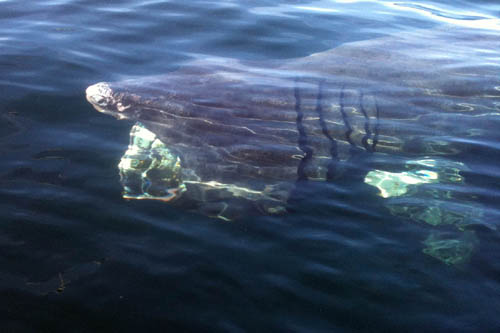THE love life of the basking shark has forced major cuts to a planned £7bn windfarm off the Scottish coast.
Scottish Power Renewables (SPR) have scaled back the enormous scheme off the Inner Hebrides after campaigners pointed out it is a breeding ground for the world’s second-biggest fish.
The 300-turbine project at Skerryvore Reef off the coast of Tiree will be cut by a third after a survey spotted nearly 1,000 of the 30ft sharks in the area in one day.

And campaigners are still pushing for the project to be scrapped entirely, saying the 30-square mile site should continue to be a haven for the sharks
They say scrapping of the windfarm would, they claim, also protect Scotland’s tallest lighthouse, Skerryvore. The 165ft structure would be dwarfed by the 650ft turbines, according to campaigners.
Robert Trythall, spokesman for the No Tiree Array (NTA) group, said: “One third down, two thirds to go. We can see the finishing line now and we’re more determined than ever to get this thing sunk.”
A survey carried out in August by the SPR found the remote western location is popular with the sea giants as they spotted 914 in one day.
The NTA hope that the findings of other surveys, due to be published next year, will prove their own claims the off-shore energy site would have an irreversible and destructive impact on the coastline.
Basking sharks are frequently spotted in Scottish waters, including Ailsa Craig, Shetland, and the waters surrounding the Hebrides.
Their mating season occurs in early summer and the ideal location for their amorous activities is shallow reef areas such as the windfarm site near Tiree
The area is also home to one of the UK’s largest water birds, the great northern diver.
Scottish Natural Heritage and Exeter University are currently tagging the basking sharks as part of a survey – the findings of which will be published in spring 2013.
Despite their size, basking sharks sustain themselves on the sea’s tiniest creatures, swimming at around 3mph with their 3ft mouths wide open filtering plankton.
The creatures filter around 220,000 gallons of water an hour, the equivalent of an Olympic swimming pool every three hours.
A Scottish Power Renewables spokesman said: “In order to minimise potential impacts on birds, including the great northern diver, we are considering a revision to the design of the windfarm to exclude either part or all of the Skerryvore Reef area, including the overall size of the windfarm.
“Doing this would also avoid an area where basking sharks are present as well as avoiding Skerryvore Lighthouse.
“We have been carrying out comprehensive surveys in the area since 2010 to better understand the ecology around the site.
“This work is necessary for any proposed development and will shape and inform the design of the windfarm and our future planning application.”
The future of windfarms was the subject of a massive political row this week after after newly-appointed UK Energy Minister John Hayes vowed to halt wind farm projects.
In a newspaper interview on Tuesday, just before a RenewableUK conference in Glasgow, the Tory politician agreed with campaigners who said on-shore turbines blight the landscape.
Mr Hayes said too many turbines had been allowed to “pepper” the countryside and “enough was enough”.
His comments threatened a rift with the government’s Liberal Democrat coalition partners and David Cameron told the Commons during Prime Minister’s questions the following day: “There has been no change towards renewable energy.
“Let me explain exactly — we have got a big pipeline of onshore and offshore wind projects that are coming through.”